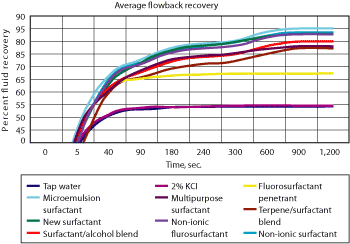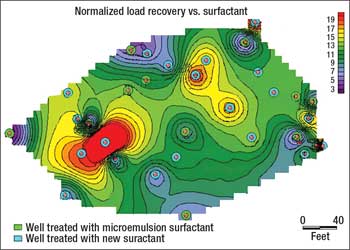Choices about fracturing fluid additives can affect production.
Leonard Kalfayan, Brandon Haley and Stephanie Weiss, BJ Services Company
The hottest onshore gas plays in North America are shales, from the Bakken, Horn River, Windsor, Antrim and Marcellus Shales in the north to the Barnett, Woodford, Haynesville and Fayetteville Shales further south. Operators are also investigating potential plays in many other regions globally.
In virtually all cases, economic production requires hydraulic fracturing, which means pumping large volumes of fluid and proppant into the formation and then waiting for the well to unload for gas production. However, in low-permeability reservoirs generally and shale gas reservoirs in particular, poor or slow fluid recovery can result from the effects of formation capillary pressure, formation wetting characteristics and unfavorable gas-water surface tension conditions.
To address these interacting properties, a flowback enhancement additive, typically containing a surfactant, may be included in the fracturing fluid system. Myriad options are commercially available. Choosing the right surfactant is critical to optimizing the flowback, although in some cases fracturing without a flowback additive may even provide the better result.
One way to optimize stimulation fluid flowback in a particular area is to conduct a multi-well field treatment study with different flowback additives (in varying concentration) and without flowback additive. However, that is not often practical. Operators and pumping service providers would obviously prefer to find a repeatable, robust laboratory evaluation method to maximize stimulation fluid flowback volume and minimize flowback time in a variety of formation types.
FLOWBACK FROM SHALE
Shale reservoirs comprise fine-grained sedimentary rock with siliceous and carbonaceous material. Most of the shale reservoirs in North America are thermogenic systems, producing dry gas from intervals ranging from 100 to over 1,000 ft. Biogenic reservoirs, such as the Antrim Shale in Michigan, may produce large quantities of water with the gas. Some shale wells can produce relatively low volumes of gas through natural fractures, but virtually all shale reservoirs need hydraulic fracturing to achieve economic production.1
These generalities belie the underlying fact that each shale reservoir is unique, and properties such as hydrocarbon content, fracture barriers and mineralogy vary within each basin and often within a field. Thus, it’s critical to understand specific reservoir properties when designing stimulation treatments.
Two common factors involved in optimizing stimulation treatments for low-permeability gas wells are fluid flowback volume and flowback time. When these factors are balanced-i.e., maximizing flowback volume and minimizing flowback time-the result is a more immediate and greater post-stimulation gas production rate.
However, capillary pressure rises as permeability drops. In undersaturated reservoirs, especially, small amounts of water invading the near-fracture area can significantly reduce the relative permeability to gas. This culminates in the capillary end effect-a slightly higher than average capillary pressure at the formation/fracture interface. Gas breakthrough then creates a channel of high relative permeability to gas, through which the gas preferentially flows, rather than breaking through at additional water-saturated locations along the frac face.2 In post-fracturing simulations, this phase trapping at the frac-formation interface appears as a reduction in the effective frac length, although the fracture may actually be optimal.
To minimize these problems and improve flowback, surfactants are often included in the frac fluid.
SURFACTANT PROPERTIES
Surfactants are formulations containing one or more surface-acting agents, typically used in stimulation fluids to:
- Reduce surface tension between the fluid and the formation, easing fluid recovery more easily after the frac (Some surfactant solutions include solvents to achieve better contact with the formation face by penetrating oil or other contaminants.)
- Reduce surface tension between treating fluid and gas, helping to maximize fluid recovery and restoring relative permeability to gas
- Increase the contact angle of the leak-off fluid on pore surfaces, which can improve recovery
- Increase water-wetting of pore surfaces, which can improve relative permeability to gas
- Reduce interfacial tension between water and formation fluids, preventing water-oil emulsions that can damage permeability.
The first three properties are most relevant and useful for low-permeability gas well stimulation fluid flowback.
Historically, fluorosurfactants provided a good combination of dynamic and static surface tension reduction with good compatibility in typical stimulation fluids. However, environmental concerns led to the development of high-performance alternatives such as microemulsions and a new generation of environmentally favorable, cost-effective surfactants.
A key benefit of the newer surfactants is their very small (nano) molecular size, which enables higher performance (i.e., better ability to treat very small cracks) in low-permeability rock. In addition, their dynamic surface tension reduction in water is much better than that of the fluorosurfactants (Table 1), directly relating to improved fluid recovery.
| TABLE 1. Surface tension reduction of various surfactants in freshwater |
 |
|
The new surfactants have also been shown in the lab to provide greater (and accelerated) regained permeability in a proppant pack compared with microemulsions and fluorosurfactants, Fig. 1. Because the mechanism of enhanced load-fluid flowback is not fully understood, experiments (or “screen tests”) designed to assess regained permeability and minimal time to maximum regained permeability are the best practical methods available to the industry to assess surfactant performance.
 |
|
Fig. 1. Laboratory fluid recovery measurements for a variety of common oilfield surfactants.
|
|
It is possible, but not very practical, to validate such laboratory results with a field-wide study. One recent example did provide some useful results.
FIELD COMPARISON
An operator in the Val Verde Basin had a number of wells in the hard, laminated chert of Pinion Field in Pecos County, Texas. Well depths vary from 5,400 to 8,600 ft with a frac gradient of 0.75-0.78 psi/ft. Permeability is about 0.1 mD, so the wells require hydraulic fracturing to achieve economic gas production. Typical stimulations comprise an acid spearhead followed by a pre-pad of KCl (because of water-sensitivity concerns) and two to three stages of linear gel, 30% CO2 and crosslinked low-pH fluid carrying 20/40 proppant.
Although the wells achieved good production after fracture stimulation, the operator wondered if there were some means of reducing the flowback period and overall job cost without adversely affecting production.
After seeing laboratory results for a new non-ionic surfactant, the operator decided to use it in a field study, comparing its performance against offsets fraced with older, more expensive microemulsion surfactants. After the first 17 jobs, the operator agreed that the flowback performance was at least as good as previously used premium surfactants and extended the trial to better assess the results.
After 44 stimulation treatments using more than 17,400 gal of new surfactant, the operator provided a number of metrics attesting to the fluid’s performance:
- Wells treated with new surfactant recovered an average of 53% of the frac fluid after 4-5 months, compared with 45% in 5-11 months with the prior surfactant, Fig. 2.
- The lower cost of new surfactant reduced the treatment costs for the operator by an average of 6-10% per job.
- The new surfactant appeared to have aided in increasing production by an average of about 12%.
 |
|
Fig. 2. Load recovery vs. surfactant for a set of low-permeability wells in Pinion Field of West Texas.
|
|
ROBUST LABORATORY ANALYSIS
As mentioned above, such field-wide studies are not practical in most oilfield situations, leading to the need for a more practical but equally reliable method of choosing surfactants for a well or field. The challenge for the industry is to develop meaningful and acceptable laboratory evaluation methods that can translate to selection of optimum surfactant (or flowback enhancement additive) and additive concentration for particular formation categories and conditions-or indication of those cases for which it is best not to include a flowback enhancement additive. 
LITERATURE CITED
1 Schein, G. W. and D. J. Mack, “Unconventional gas,” Ch. 11 in M. Economides and T. Martin, eds., Modern Fracturing, Energy Tribune Publishing, Houston, 2007, pp. 381-423.
2 Penney, G., Pursley, J. T. and D. Holcomb, “The application of microemulsion additives in drilling and stimulation results in enhanced gas production,” SPE 94274 presented at the SPE Production and Operations Symposium, Oklahoma City, April 17-19, 2005.
|
THE AUTHORS
|
|
|
Leonard Kalfayan has 28 years of experience in the petroleum industry in production enhancement technology and business development. He is the Senior Advisor of Production Enhancement for BJ Services in Houston, Texas. He previously worked for Unocal and as an independent consultant in oil, gas and geothermal well stimulation, water conformance and mature field remedial services. He is a past Society of Petroleum Engineers Distinguished Lecturer.
|
|
| |
Brandon Haley is a Region Engineer for BJ Services in the Permian Region. Mr. Haley began his career with BJ Services in 2005 after earning a BS degree in petroleum engineering from Texas Tech University.
|
|
| |
Stephanie Weiss is Senior Technical Editor at BJ Services. Before joining the company in 2006, she worked in the photonics industry. She has a bachelor’s degree from Southern Methodist University.
|
|
| |
|
|






